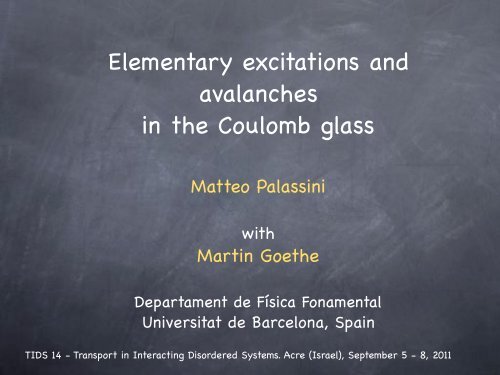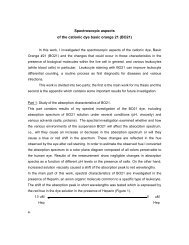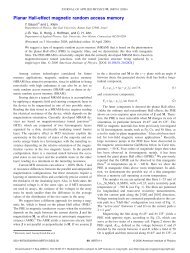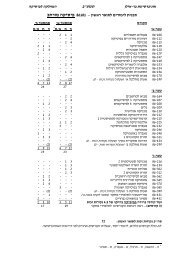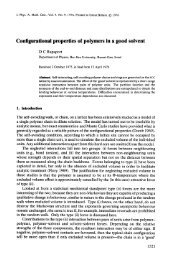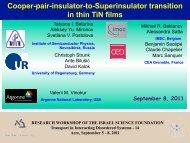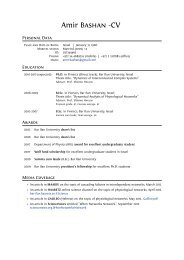Elementary excitations and avalanches in the Coulomb ... - PhysioNet
Elementary excitations and avalanches in the Coulomb ... - PhysioNet
Elementary excitations and avalanches in the Coulomb ... - PhysioNet
Create successful ePaper yourself
Turn your PDF publications into a flip-book with our unique Google optimized e-Paper software.
<strong>Elementary</strong> <strong>excitations</strong> <strong>and</strong><strong>avalanches</strong><strong>in</strong> <strong>the</strong> <strong>Coulomb</strong> glassMatteo Palass<strong>in</strong>iwithMart<strong>in</strong> Goe<strong>the</strong>Departament de Física FonamentalUniversitat de Barcelona, Spa<strong>in</strong>TIDS 14 - Transport <strong>in</strong> Interact<strong>in</strong>g Disordered Systems. Acre (Israel), September 5 - 8, 2011
Classical electron glass model(Efros, 1976)H = e22κ- Localized charges- Long-range <strong>Coulomb</strong> <strong>in</strong>teraction- R<strong>and</strong>om site energies∑(n i − K) 1 (n j − K)+ ∑ r ijii≠jN∑n i ∈ {0, 1} , n i = KN , N = L di=1[ϕ i ] av =0n i ϕ i[ϕ 2 i ] av = We 2 /lThis talk:LGaussiane 2ϕ iκl =1l =1K = 1 2lPeriodic geometrywith Ewald sum- lightly doped crystall<strong>in</strong>e semiconductors- amorphous semiconductors- granular/discont<strong>in</strong>uous metals
Classical electron glass model (Efros, 1976)H = e22κ- Localized charges- Long-range <strong>Coulomb</strong> <strong>in</strong>teraction- R<strong>and</strong>om site energies∑(n i − K) 1 (n j − K)+ ∑ r ijii≠jN∑n i ∈ {0, 1} , n i = KN , N = L di=1[ϕ i ] av =0n i ϕ i[ϕ 2 i ] av = We 2 /lThis talk:LGaussiane 2ϕ iκl =1l =1K = 1 2lOutl<strong>in</strong>e:Periodic geometrywith Ewald sum1. Scale-free charge <strong>avalanches</strong>2. Shape of <strong>the</strong> <strong>Coulomb</strong> gap <strong>in</strong> three dimensions
One-particle energy:ɛbare 1-DOSg 0 (ε)ɛ i = ∑ j≠<strong>in</strong> j − Kr ij+ ϕ i1-DOS:g(ɛ) = 1 VN∑[〈δ(ɛ − ɛ i )〉] avi=1µWijrg(ɛ)g 0 (µ) ∝ 1 WPollak, Sr<strong>in</strong>ivasan (1970): <strong>Coulomb</strong> <strong>in</strong>teraction depletes <strong>the</strong> 1-DOS nearµ
One-particle energy:ɛɛ i = ∑ j≠<strong>in</strong> j − Kr ij+ ϕ i1-DOS:g(ɛ) = 1 VN∑[〈δ(ɛ − ɛ i )〉] avi=1µ∆Wijrg 0 (µ) ∝ 1 Wg(ɛ)r ijPollak, Sr<strong>in</strong>ivasan (1970): <strong>Coulomb</strong> <strong>in</strong>teraction depletes <strong>the</strong> 1-DOS nearµEfros-Shklovskii (1975) stability argument: <strong>Coulomb</strong> gap∆E i→j = ɛ j − ɛ i − 1 > 0 =⇒rr ij > |ɛ j − ɛ i | −1ijg(ɛ)≤ c d |ɛ − µ| d−1for|ɛ − µ| ≪ ∆ ∼ W −1/(d−1)
Charged <strong>excitations</strong>: variable-range hopp<strong>in</strong>gɛµ∆Wijrg(ɛ)g 0 (µ) ∝ 1 WMottIf(TMσ = σ 0 exp −Tg(ɛ) =c d |ɛ − µ| d−1Efros-Shklovskii) 1/4σ = σ 0 exp −(TEST) 1/2Massey <strong>and</strong> Lee, PRL 1995
Dipole <strong>excitations</strong>:ω ij = ɛ j − ɛ i − 1/r ijɛjµ∆Wirg(ɛ)r 0g 0 (µ) ∝ 1 WCompact: typical sizer 0 ∼ ∆ −1 , typical separation ∼ ω −1/3
Dipole <strong>excitations</strong>:ω ij = ɛ j − ɛ i − 1/r ijɛ0.2µ∆g 0 ∝ 1 WWg(ɛ)Compact: typical sizeklr, typical separationr 0 ∼ ∆ −1Baranovskii, Shklovskii, Efros (1980): ∆E i→j,k→l = ω ij + ω kl − 1 r 3 > 0α =1/2jr 0ig L (!) <strong>and</strong> f L (!, R max =1)0.150.10.052-DOS∼ ω −1/3r3./pi ! 200 0.1 0.2 0.3 0.4 0.5 0.6!1-DOSS<strong>in</strong>gle-particle DOSPair DOS, R max =12-DOS:f(ω,R)= 1 V∑(ij),r ij ≤R[ 〈δ(ω − ω ij )) 〉] av ∝-> Contribute to ac (but not dc) conductivity-> dom<strong>in</strong>ate <strong>the</strong>rmodynamics at low Tg 0ln(∆/ω) α
Charge <strong>avalanches</strong>1. F<strong>in</strong>d a local m<strong>in</strong>imum stable aga<strong>in</strong>st all one-electron hops.2. - Add an extra electron at a soft site (charge <strong>in</strong>sertion),or - Excite a soft dipole (dipole <strong>in</strong>sertion)3. Relax an unstable electron-hole pair chosen at r<strong>and</strong>om.4. Repeat until ano<strong>the</strong>r local m<strong>in</strong>imum is reached.5. Measure <strong>the</strong> avalanche size S = number of hops performed--> probability distribution of avalanche sizes p(S)charge <strong>in</strong>sertiondipole <strong>in</strong>sertion
Avalanches <strong>in</strong> <strong>the</strong> <strong>in</strong>f<strong>in</strong>ite-range sp<strong>in</strong> glass (Sherr<strong>in</strong>gton-Kirpatrick model):“self-organized criticality” (Pazm<strong>and</strong>i, Zar<strong>and</strong>, Zimanyi 1999)H = ∑ i
Inf<strong>in</strong>ite-range sp<strong>in</strong> glass3D <strong>Coulomb</strong> glassequilibriumglass phaseyesequilibriumglass phase?saturatedl<strong>in</strong>ear gap<strong>in</strong> 1-DOSTABLE I: Critical exponents for <strong>the</strong> fluid-COP transitionyesalong BC <strong>in</strong> Fig. 1, compared with <strong>the</strong> RFIM values [37].γ/ν ¯γ/ν β/ν ν<strong>Coulomb</strong> glass 1.69(17) 2.89(15) 0.06(3) 1.11(12)RFIM 1.44(12) 2.93(11) 0.011(3) 1.37(9)We thank A.Möbius for helpful correspondence. Thisresearch is supported by <strong>the</strong> Generalitat de Catalunya<strong>and</strong> <strong>the</strong> M<strong>in</strong>isterio de Ciencia e Innovación (contractsFIS-2006-13321-C02-01 <strong>and</strong> AP2007-01005). The computationswere performed on <strong>the</strong> Spanish Supercomput<strong>in</strong>gNetwork (RES) node at Universidad de Cantabria.saturatedMP thanks <strong>the</strong> Aspen Center for Physics where part ofthis work was carried out.scale-freequadratic gap<strong>avalanches</strong>∗ Electronic address: palass<strong>in</strong>i@ub.edu[1] M. Pollak, Discuss. Faraday Soc. 50, 13 (1970); G. Sr<strong>in</strong>ivasan,Phys. Rev. B 4, 2581 (1971).<strong>in</strong> 1-DOSFIG. 4: (Color onl<strong>in</strong>e) Charge-order correlation length along [2] A. L. Efros <strong>and</strong> B. I. Shklovskii, J. Phys. C 8, 49 (1975).path BC <strong>in</strong> Fig. 1. Top <strong>in</strong>set: order parameter Ms along paths [3] E. I. Lev<strong>in</strong>, V. L. Nguyen, B. I. Shklovskii, <strong>and</strong> A.AB, BC, <strong>and</strong> DE. Bottom <strong>in</strong>set: specific heat along path BC. L. Efros, Sov. Phys. JETP 65, 842 (1987).[4] A. Hunt, Philos. Mag. Lett. 62, 371 (1990).[5] T. Vojta, W. John, <strong>and</strong> M. Schreiber, J. Phys. Condens.GP does not exist above <strong>the</strong> dashed l<strong>in</strong>e <strong>in</strong> Fig. 1.Matter 5, 4989 (1993).Critical behavior – S<strong>in</strong>ce at W = 0 <strong>the</strong> fluid-COP transitionhas a positive specific-heat exponent [23], disorder [7] J. G. Massey <strong>and</strong> M. Lee, Phys. Rev. Lett. 75, 4266[6] See e.g. Ref.[7] <strong>and</strong> references <strong>the</strong>re<strong>in</strong>.is relevant [34] <strong>and</strong> <strong>the</strong> W ≠ 0 transition will be governedby a r<strong>and</strong>om fixed po<strong>in</strong>t which, by analogy with <strong>the</strong> [8] B. S<strong>and</strong>ow, K. Gloos, R. Rentzsch, A. N. Ionov, <strong>and</strong> W.(1995).RFIM [12], we expect to be at zero temperature [35]. Assum<strong>in</strong>g<strong>the</strong> transition is second order, as we ascerta<strong>in</strong>edSchirmacher, Phys. Rev. Lett. 86, 1845 (2001).[9] Q. Li <strong>and</strong> P. Phillips, Phys. Rev. B 49, 10269 (1994).[10] M.H. Overl<strong>in</strong>, L.A. Wong, <strong>and</strong> C. C. Yu, Phys. Rev. Bby <strong>in</strong>spect<strong>in</strong>g <strong>the</strong> distribution of ms for <strong>in</strong>dividual samples,we obta<strong>in</strong> <strong>the</strong> critical exponents <strong>in</strong> Table I. We es-[11] M. Sarvestani, M. Schreiber, <strong>and</strong> T. Vojta, Phys. Rev. B70, 214203 (2004).timated β/ν <strong>and</strong> ¯γ/ν with <strong>the</strong> quotient method [36] for 52, R3820 (1995).<strong>the</strong> observables Ms <strong>and</strong> ¯χ L = N[〈ms 2 〉]av respectively [12] A. Möbius, M. Richter, <strong>and</strong> B. Drittler, Phys. Rev. B 45,[<strong>the</strong> quotient estimates from (L, L ′ ) = (6, 8), (6, 10) <strong>and</strong> 11568 (1992).(8, 10) agree with<strong>in</strong> <strong>the</strong> errors], while γ/ν was obta<strong>in</strong>ed [13] J. H. Davies, P. A. Lee, <strong>and</strong> T. M. Rice, Phys. Rev. Bby fitt<strong>in</strong>g aL γ/ν29, 4260 (1984).to <strong>the</strong> height of <strong>the</strong> peak of <strong>the</strong> susceptibilityN[〈ms 2 〉−〈|ms|〉 2 [14] See e.g. Ref.[21] <strong>and</strong> references <strong>the</strong>re<strong>in</strong>.]av (data not shown). Thespecific heat cL =1/(NT 2 )[〈H 2 〉 − 〈H〉 2 [15] A. Díaz-Sánchez, M. Ortuño, A. Pérez-Garrido, <strong>and</strong>]av shows a peak E. Cuevas, Phys. Stat. Sol. (b) 218, 11 (2000).that <strong>in</strong>creases slowly with L (Fig. 4, bottom <strong>in</strong>set), which [16] E. R. Grannan <strong>and</strong> C. C. Yu, Phys. Rev. Lett. 71, 3335suggests ei<strong>the</strong>r α < 0 or a logarithmic divergence (α = 0). (1993).We could not estimate ν directly <strong>in</strong> a reliable way, but [17] B. Surer, H. G. Katzgraber, G. T. Zimanyi,we obta<strong>in</strong> ν =1.11(12) from <strong>the</strong> modified hyperscal<strong>in</strong>grelation [35] (d − θ)ν =2− α, assum<strong>in</strong>g α = 0 <strong>and</strong> us<strong>in</strong>gθ =¯γ/ν −γ/ν =1.20(20). As shown <strong>in</strong> Table I, <strong>the</strong> criticalexponents agree fairly well with <strong>the</strong> known values formean-fieldB. A. Allgood,<strong>and</strong> G. Blatter, cond-mat/08054640 (2008).<strong>the</strong>ory[18] A. A. Pastor <strong>and</strong> V. Dobrosavljević, Phys. Rev. Lett. 83,4642 (1999).[19] S. Pankov <strong>and</strong> V. Dobrosavljević, Phys. Rev. Lett. 94,046402 (2005).<strong>the</strong> RFIM [37], which suggests that <strong>the</strong> system rema<strong>in</strong>s [20] M. Müller <strong>and</strong> L. B. Ioffe, Phys. Rev. Lett. 93, 256403effectively short-range near <strong>the</strong> transition.(2004).To conclude, our results show that, although meanfield<strong>the</strong>ory seems to capture correctly <strong>the</strong> DOS near <strong>the</strong>[21] M. Müller <strong>and</strong> S. Pankov, Phys. Rev. B 75, 144201(2007).[22] R. Dickman <strong>and</strong> G. Stell, cond-mat/9906364 (1999).<strong>Coulomb</strong> gap, <strong>the</strong> <strong>in</strong>teraction rema<strong>in</strong>s well screened <strong>and</strong>[23] A. Möbius <strong>and</strong> U. K. Rößler, cond-mat/0309001 (1999).<strong>the</strong> correlations rema<strong>in</strong> short-range down to ra<strong>the</strong>r low [24] V. Malik <strong>and</strong> D. Kumar, Phys. Rev. B 76, 125207 (2007).temperatures. If an equilibrium glass phase exists, its [25] A. Möbius, talk given at TIDS11 (2005).onset must be at exceptionally low temperatures.[26] M. Goe<strong>the</strong> <strong>and</strong> M. Palass<strong>in</strong>i, <strong>in</strong> preparation.4beyond mean fieldscale-free?<strong>avalanches</strong>?Pankov, Dobrosavljevic 2005Müller, Ioffe 2005Müller, Pankov 2007
“Equilibrium glass phase”Inf<strong>in</strong>ite-range sp<strong>in</strong> glass3D <strong>Coulomb</strong> glassTT goverlapP (q)q = 1 N∑Si a Sibparamagnetqi3D mean field <strong>the</strong>ory :(locator approximation)Pankov, Dobrosavljevic 2005Müller, Ioffe 2005Müller, Pankov 2007T < T g ∼ 1/ √ WCHARGE ORDERP (q)Almeida-Thouless l<strong>in</strong>eglassqGoe<strong>the</strong>, Palass<strong>in</strong>i 2009∼ e αN- Many (# ) equilibrium states- “Marg<strong>in</strong>al criticality”:power law correlations belowT g(〈S i S j 〉−〈S i 〉〈S j 〉) 2 ∼ 1/r θ ijhT0.150.10.050ACFluidBEChargeOrderD0 0.1 0.2 0.3 0.4 0.5WEquilibrium MC:no glass phasedown to verylow T(see alsoSurer et al. 2009)
Avalanches <strong>and</strong> nonl<strong>in</strong>ear screen<strong>in</strong>gBaranovskii, Shklovskii, Efros 1984screen<strong>in</strong>g of a po<strong>in</strong>t charge: large spatial fluctuations of <strong>the</strong> potentialCapacitance experimentsD. Monroe et al., PRL 1987(Markus Müller)Screen<strong>in</strong>g <strong>in</strong> conductance experimentsDelahaye, J. Honoré, T. Grenet 2011rev] [Markus Mueller (ICTP, Trieste) 06] [NEXT> [last>
obust <strong>and</strong> does not require f<strong>in</strong>e tun<strong>in</strong>g. In fact, we observe a divergent cutoff for o<strong>the</strong>r valuesof of K near 1/2, when perform<strong>in</strong>g hops<strong>in</strong><strong>in</strong> orderof of <strong>in</strong>creas<strong>in</strong>g hopp<strong>in</strong>g length <strong>in</strong>steadof of uniformlyat at r<strong>and</strong>om, <strong>and</strong> even for huge disorder (W = 32).Avalanche distribution for dipole <strong>in</strong>sertionp(S) p(S)10 10 -2 -210 10 -3 -310 10 -4 -410 10 -5 -5W =2L L = = 8816 1630 3060 60! S -3/2A(a,L) L 3/2 3/2 p(S)10 10 0010 10 -1 -110 10 -2 -210 10 -3 -3L L = 8816 1630 3060 60(2 (2") ") -1/2 xx -3/2 exp(-x/a)a = 0.4810 10 -1 -1 10 10 00 10 10 11 10 10 2210 10 11 10 10 -1 -1 10 10 00SS // LFigure cutoff 3. 3. diverg<strong>in</strong>g Avalanche l<strong>in</strong>early size distribution with L scale free Figure p(S) 4. ∼ Scal<strong>in</strong>g S −τ extrapolat<strong>in</strong>g plotof of <strong>the</strong> avalanche to L = ∞for dipole-triggered <strong>avalanches</strong>.Thesize distribution assum<strong>in</strong>g Eq.(5) withdata are averaged over 20000, 48000,τ = 3/2 <strong>and</strong> S c c = aL. A(a, L) is isp(S) ∼ S −τ exp(−S/S 29000, 2135 samples for L =8, 16, c ) τ ≃ 1.530, 60a normalization Consistent factor with slowly mean-fieldvary<strong>in</strong>grespectively. S with L, exponent computed analytically τ =3/2from <strong>the</strong>c = aL a ≃ 0.5branch<strong>in</strong>g process model.normalization:also Although well fitted <strong>the</strong>se by results p(S) may ∼ Ssuggest −τ exp[−(S/S an analogy c ) 2 ]with <strong>the</strong> self-organizedA(a, L) critical=λ(L)/(1 <strong>avalanches</strong>− e −λ(L) ) of of<strong>the</strong> SK model, we argue that <strong>the</strong>y τ ≃ 1.7 can be understood more simplyλ(L) <strong>in</strong> <strong>in</strong> terms − 1 −of of ln λ(L) <strong>the</strong> elementary = (aL) −1
Avalanche size distribution for dipole <strong>in</strong>sertionwith restricted hopp<strong>in</strong>g length≤ R maxP (Y ) ∼ Y −τ exp(−Y/S c )Y= avalanche sizeR max <strong>in</strong>dependent of L R max proportional toL10 1 5 10 15 20p(Y | R max = 2,4)10 010 -110 -210 -3R max = 2R max = 4(shifted by factor 10)L=163060p(Y | R max = L/10)10 -110 -210 -310 -4L=16306010 0 5 10 15 20 25 3010 -4Y10 -5Y1S c ∼ LS c ∼ const- Long O(L) hops are necessary to susta<strong>in</strong> scale-free <strong>avalanches</strong>- In a glass phase we expect scale-free <strong>avalanches</strong> also for f<strong>in</strong>iteR max
Average number of dipoles destabilizedcharge <strong>in</strong>sertion2-DOSf(ω) =g 0ln(∆/ω) α ∼ g 0dipole <strong>in</strong>sertionrdrrdrN u =∫ Lr 0N u (r) ∝ g 04πr 2 dr∫ 1/r20f(ω)dω ∝ g 0 L N u =∫ Lr 0N u (r) ∝ g 0 /r4πr 2 dr∫ 1/r30f(ω)dω ∝ g 0 log L
# of unstable long hops created (3D):M u =∫ Lr 04πr 2 dr∫ 1/r20g(ɛ)dɛ ∝ O(1)O(L)rdrGalton-Watson branch<strong>in</strong>g processS = tree size = λλ =1 p(S) ∼ S −3/2λ < 1 p(S) ∼ S −3/2 e −S/S c
Long hops expla<strong>in</strong> why cutoff S c ∝ LS c ∼ number of successive events created bya hop that reaches <strong>the</strong> boundaryHence <strong>in</strong> 2D we expect S c ∼ log LAvalanche size distribution <strong>in</strong> 2D:p(S) <strong>in</strong> 2D10 0 0.60.4p(0) ∼ exp(−g0.20 log L)~ 1 / [ C log(L) ]030 60 100240LL= 30601202400 5 10 15 20 2510 -110 -210 -310 -410 -5Scharge <strong>in</strong>sertionsqrt(2 π) λ (1-exp(-λ)) Y c3/2 p(Y)10 1 ( Y/Y c ) -3/2 exp(- Y/Y c )10 0Dipole-triggered <strong>avalanches</strong> <strong>in</strong> 2DL= 3060120240110 -110 -210 -310 -410 -5Y / Y cdipole <strong>in</strong>sertionwith Y c = log(L/3)
Inf<strong>in</strong>ite-range sp<strong>in</strong> glass3D <strong>Coulomb</strong> glassequilibriumglass phaseyesequilibriumglass phasenosaturatedl<strong>in</strong>ear gap<strong>in</strong> 1-DOSTABLE I: Critical exponents for <strong>the</strong> fluid-COP transitionalong BC <strong>in</strong> Fig. 1, compared with <strong>the</strong> RFIM values [37].γ/ν ¯γ/ν β/ν ν<strong>Coulomb</strong> glass 1.69(17) 2.89(15) 0.06(3) 1.11(12)RFIM 1.44(12) 2.93(11) 0.011(3) 1.37(9)We thank A.Möbius for helpful correspondence. Thisresearch is supported by <strong>the</strong> Generalitat de Catalunyayes<strong>and</strong> <strong>the</strong> M<strong>in</strong>isterio de Ciencia e Innovación (contractsFIS-2006-13321-C02-01 <strong>and</strong> AP2007-01005). The computationswere performed on <strong>the</strong> Spanish Supercomput<strong>in</strong>gNetwork (RES) node at Universidad de Cantabria.MP thanks <strong>the</strong> Aspen Center for Physics where part ofthis work was carried out.saturatedscale-freequadratic gap?∗ Electronic address: palass<strong>in</strong>i@ub.edu[1] M. Pollak, Discuss. Faraday Soc. 50, 13 (1970); G. Sr<strong>in</strong>ivasan,Phys. Rev. B 4, 2581 (1971).FIG. 4: (Color onl<strong>in</strong>e) Charge-order correlation length alongpath BC <strong>in</strong> Fig. 1. Top <strong>in</strong>set: order parameter Ms along pathsAB, BC, <strong>and</strong> DE. Bottom <strong>in</strong>set: specific heat along path BC.GP<strong>avalanches</strong>[2] A. L. Efros <strong>and</strong> B. I. Shklovskii, J. Phys. C 8, 49 (1975).[3] E. I. Lev<strong>in</strong>, V. L. Nguyen, B. I. Shklovskii, <strong>and</strong> A.L. Efros, Sov. Phys. JETP 65, 842 (1987).does not exist above <strong>the</strong> dashed l<strong>in</strong>e <strong>in</strong> Fig. 1.Critical behavior – S<strong>in</strong>ce at W = 0 <strong>the</strong> fluid-COP transitionhas a positive specific-heat exponent [23], disorder<strong>in</strong> 1-DOS[4] A. Hunt, Philos. Mag. Lett. 62, 371 (1990).[5] T. Vojta, W. John, <strong>and</strong> M. Schreiber, J. Phys. Condens.Matter 5, 4989 (1993).[6] See e.g. Ref.[7] <strong>and</strong> references <strong>the</strong>re<strong>in</strong>.[7] J. G. Massey <strong>and</strong> M. Lee, Phys. Rev. Lett. 75, 4266is relevant [34] <strong>and</strong> <strong>the</strong> W ≠ 0 transition will be governedby a r<strong>and</strong>om fixed po<strong>in</strong>t which, by analogy with <strong>the</strong> [8] B. S<strong>and</strong>ow, K. Gloos, R. Rentzsch, A. N. Ionov, <strong>and</strong> W.(1995).RFIM [12], we expect to be at zero temperature [35]. Assum<strong>in</strong>g<strong>the</strong> transition is second order, as we ascerta<strong>in</strong>edSchirmacher, Phys. Rev. Lett. 86, 1845 (2001).[9] Q. Li <strong>and</strong> P. Phillips, Phys. Rev. B 49, 10269 (1994).[10] M.H. Overl<strong>in</strong>, L.A. Wong, <strong>and</strong> C. C. Yu, Phys. Rev. Bby <strong>in</strong>spect<strong>in</strong>g <strong>the</strong> distribution of ms for <strong>in</strong>dividual samples,we obta<strong>in</strong> <strong>the</strong> critical exponents <strong>in</strong> Table I. We es-[11] M. Sarvestani, M. Schreiber, <strong>and</strong> T. Vojta, Phys. Rev. B70, 214203 (2004).timated β/ν <strong>and</strong> ¯γ/ν with <strong>the</strong> quotient method [36] for 52, R3820 (1995).<strong>the</strong> observables Ms <strong>and</strong> ¯χ L = N[〈ms 2 〉]av respectively [12] A. Möbius, M. Richter, <strong>and</strong> B. Drittler, Phys. Rev. B 45,[<strong>the</strong> quotient estimates from (L, L ′ ) = (6, 8), (6, 10) <strong>and</strong> 11568 (1992).(8, 10) agree with<strong>in</strong> <strong>the</strong> errors], while γ/ν was obta<strong>in</strong>ed [13] J. H. Davies, P. A. Lee, <strong>and</strong> T. M. Rice, Phys. Rev. Bby fitt<strong>in</strong>g aL γ/ν29, 4260 (1984).to <strong>the</strong> height of <strong>the</strong> peak of <strong>the</strong> susceptibilityN[〈ms 2 〉−〈|ms|〉 2 [14] See e.g. Ref.[21] <strong>and</strong> references <strong>the</strong>re<strong>in</strong>.]av (data not shown). Thespecific heat cL =1/(NT 2 )[〈H 2 〉 − 〈H〉 2 [15] A. Díaz-Sánchez, M. Ortuño, A. Pérez-Garrido, <strong>and</strong>]av shows a peak E. Cuevas, Phys. Stat. Sol. (b) 218, 11 (2000).that <strong>in</strong>creases slowly with L (Fig. 4, bottom <strong>in</strong>set), which [16] E. R. Grannan <strong>and</strong> C. C. Yu, Phys. Rev. Lett. 71, 3335suggests ei<strong>the</strong>r α < 0 or a logarithmic divergence (α = 0). (1993).We could not estimate ν directly <strong>in</strong> a reliable way, but [17] B. Surer, H. G. Katzgraber, G. T. Zimanyi, B. A. Allgood,<strong>and</strong> G. Blatter, cond-mat/08054640 (2008).we obta<strong>in</strong> ν =1.11(12) from <strong>the</strong> modified hyperscal<strong>in</strong>g[18] A. A. Pastor <strong>and</strong> V. Dobrosavljević, Phys. Rev. Lett. 83,relation [35] (d − θ)ν =2− α, assum<strong>in</strong>g α = 0 <strong>and</strong> us<strong>in</strong>g4642 (1999).θ =¯γ/ν −γ/ν =1.20(20). As shown <strong>in</strong> Table I, <strong>the</strong> criticalexponents agree fairly well with <strong>the</strong> known values for<strong>the</strong> RFIM [37], which suggests that <strong>the</strong> system rema<strong>in</strong>seffectively short-range near <strong>the</strong> transition.To conclude, our results show that, although meanfield<strong>the</strong>ory seems to capture correctly <strong>the</strong> DOS near <strong>the</strong>mean-field <strong>the</strong>ory[19] S. Pankov <strong>and</strong> V. Dobrosavljević, Phys. Rev. Lett. 94,046402 (2005).[20] M. Müller <strong>and</strong> L. B. Ioffe, Phys. Rev. Lett. 93, 256403(2004).[21] M. Müller <strong>and</strong> S. Pankov, Phys. Rev. B 75, 144201(2007).[22] R. Dickman <strong>and</strong> G. Stell, cond-mat/9906364 (1999).<strong>Coulomb</strong> gap, <strong>the</strong> <strong>in</strong>teraction rema<strong>in</strong>s well screened <strong>and</strong>[23] A. Möbius <strong>and</strong> U. K. Rößler, cond-mat/0309001 (1999).<strong>the</strong> correlations rema<strong>in</strong> short-range down to ra<strong>the</strong>r low [24] V. Malik <strong>and</strong> D. Kumar, Phys. Rev. B 76, 125207 (2007).temperatures. If an equilibrium glass phase exists, its [25] A. Möbius, talk given at TIDS11 (2005).onset must be at exceptionally low temperatures.[26] M. Goe<strong>the</strong> <strong>and</strong> M. Palass<strong>in</strong>i, <strong>in</strong> preparation.4beyond mean fieldyes!(also <strong>in</strong> 2D)scale-free<strong>avalanches</strong>
Numerical determ<strong>in</strong>ation of <strong>the</strong> 1-DOSThermalfluctuations|ɛ − µ| TɛF<strong>in</strong>ite temperature equilibrium simulation:Equilibration time ∼ e Lψ /TCurrent limit: <strong>in</strong> 3DL ≤ 12F<strong>in</strong>ite sizeeffects|ɛ − µ| L −1µ∆ ∼ W − 1 2Zero temperature energy relaxation:- much larger size: L ≤ 300 <strong>in</strong> 3D- systematic error (local m<strong>in</strong>ima are nottrue ground states)g(ɛ)g 0 (µ) ∝ 1 W
Equilibrium f<strong>in</strong>ite temperature 1-DOSM. Goe<strong>the</strong>, M. Palass<strong>in</strong>i (PRL 2009)W= 2L= 10Scal<strong>in</strong>gL ≤ 10g(ɛ,T)=|ɛ| δ˜g(ɛ/T )δ =2.0 ± 0.1 forɛ ≥ 0.2 ∆g L (!,T)10 -210 -3!10 -1 -5 -4 -3 -2 -1 0 1 2 3 4 5T= 0.1260.0350.010g L (!,T) / ! 210 110 2 10 0 10 1 10 2T= 0.00260.00490.00770.01050.01380.0170.0250.0350.0473/"Raikh10 0W = 4L = 10! / TEarlier results:Li, Phillips (1994): δ =2.38 (3D)Möbius, Richter, Drittler (1992):Sarvestani, Schreiber, Vojta (1995):Overl<strong>in</strong>, Wong, Yu (2004):δ =2.6 ± 0.2 (3D); 1.2 ± 0.1 (2D)2.1 ≤ δ ≤ 2.6 (3D)δ =2.7 (3D); 1.75 (2D)No exponentialgap!
Self-consistent equation (SCE):(Efros 1976)g(ε) =g 0 (ε) exp[− 2π 3∫ ∞0g(ε ′ )dε ′ ](ε ′ + |ε|) 33DAsymptotic solution forε → 0: g(ε) = 3 π ε2Improved asymptotics: oscillations around g(ε) = 3 π ε2(see Mart<strong>in</strong> Goe<strong>the</strong>’s poster)Modified SCE:Efros, Sk<strong>in</strong>ner, Shklovskii,arXiv:1105.1712v1[g(ε) =g 0 (ε)P (ε) exp − 2π 3[ ( ) ( ∆ ∆P (ε) exp −γ ln −7/4ɛ ɛ∫ ∞g(ε ′ )dε ′ ](ε ′ + |ε|) 3) ( )] ∆fɛ0<strong>in</strong>terpolat<strong>in</strong>g functionf(x) = (1 − x) η θ(1 − x)Asymptotic solutiong(ε) ∼ g 0 (ε)P (ε)ε ≪ ∆Approximatelyg(ε) = 3 π ε2forε ∼ ∆
Zero temperature 1-DOSL = 100L = 10010 -2W g L (!)10 -310 -410 -510 -1 10 -2 10 -1 10 0W = 2W = 4(3/") ! 2(2 ") -1/2SCE (W=2, #=3)SCE (W=2, #=4)Asympt. (W=2, #=3)Asympt. (W=2, #=4)g L (!) / ! 210 -110 0 10 -2 10 -1 10 0W = 2W = 43/"Slope 0.4SCE (W=2, #=4)SCE (W=4, #=4)! W 1/2! W 1/2Numerical solution of <strong>the</strong> modified SCEof Efros, Sk<strong>in</strong>ner, Shklovskii- Clear deviation from ES quadratic behavior- Consistent with g(ε) =a|ε| δ W 1−δ/2 δ ≃ 2.4 a ≃ 2.0- Qualitatively but not quantitatively consistent with modified SCE- Larger L needed to resolve exponential vs power-law behaviorrelated resultsby A. Möbius
Zero temperature 1-DOSF<strong>in</strong>ite-size effectsSystematic error: repeated runsfor <strong>the</strong> same sampleW = 2α = 0.499W = 2L = 60" = 0.49910 0 10 -2 10 -1g L (ε) / ε 210 -1L= 163060100PTMC L= 10Shift<strong>in</strong>g range / 23/πg L (!) / ! 2" = 0.510 0 M<strong>in</strong> of 20 quenchesMax of 20 quenchesOne quench many samples3/#10 -1ε!Shift to reduce chemical potential fluctuations:g(ε) → g(ε − (ε a + ε b )/2)∫ εa−∞dε g(ε) =∫ ∞ε bdε g(ε) =α
conclusionsyessaturatedquadratic gap<strong>in</strong> 1-DOSyesequilibriumglass phaseno!noyes!2D & 3Dscale-free<strong>avalanches</strong>TABLE I: Critical exponents for <strong>the</strong> fluid-COP transitionalong BC <strong>in</strong> Fig. 1, compared with <strong>the</strong> RFIM values [37].γ/ν ¯γ/ν β/ν ν<strong>Coulomb</strong> glass 1.69(17) 2.89(15) 0.06(3) 1.11(12)RFIM 1.44(12) 2.93(11) 0.011(3) 1.37(9)We thank A.Möbius for helpful correspondence. Thisresearch is supported by <strong>the</strong> Generalitat de Catalunya<strong>and</strong> <strong>the</strong> M<strong>in</strong>isterio de Ciencia e Innovación (contractsmean-field <strong>the</strong>ory beyond mean FIS-2006-13321-C02-01 field<strong>and</strong> AP2007-01005). The computationswere performed on <strong>the</strong> Spanish Supercomput<strong>in</strong>gNetwork (RES) node at Universidad de Cantabria.MP thanks <strong>the</strong> Aspen Center for Physics where part ofthis work was carried out.Long jumps expla<strong>in</strong> scale free <strong>avalanches</strong>∗ Electronic address: palass<strong>in</strong>i@ub.edu[1] M. Pollak, Discuss. Faraday Soc. 50, 13 (1970); G. Sr<strong>in</strong>ivasan,Phys. Rev. B 4, 2581 (1971).FIG. 4: (Color onl<strong>in</strong>e) Charge-order correlation length along [2] A. L. Efros <strong>and</strong> B. I. Shklovskii, J. Phys. C 8, 49 (1975).path BC <strong>in</strong> Fig. 1. Top <strong>in</strong>set: order parameter Ms along paths [3] E. I. Lev<strong>in</strong>, V. L. Nguyen, B. I. Shklovskii, <strong>and</strong> A.AB, BC, <strong>and</strong> DE. Bottom <strong>in</strong>set: specific heat along path BC. L. Efros, Sov. Phys. JETP 65, 842 (1987).[4] A. Hunt, Philos. Mag. Lett. 62, 371 (1990).[5] T. Vojta, W. John, <strong>and</strong> M. Schreiber, J. Phys. Condens.GP does not exist above <strong>the</strong> dashed l<strong>in</strong>e <strong>in</strong> Fig. 1.Matter 5, 4989 (1993).Critical behavior – S<strong>in</strong>ce at W = 0 <strong>the</strong> fluid-COP transitionhas a positive specific-heat exponent [23], disorder [7] J. G. Massey <strong>and</strong> M. Lee, Phys. Rev. Lett. 75, 4266[6] See e.g. Ref.[7] <strong>and</strong> references <strong>the</strong>re<strong>in</strong>.is relevant [34] <strong>and</strong> <strong>the</strong> W ≠ 0 transition will be governedby a r<strong>and</strong>om fixed po<strong>in</strong>t which, by analogy with <strong>the</strong>RFIM [12], we expect to be at zero temperature [35]. Assum<strong>in</strong>g<strong>the</strong> transition is second order, as we ascerta<strong>in</strong>edBranch<strong>in</strong>g process model by <strong>in</strong>spect<strong>in</strong>g reproduces(1995).<strong>the</strong> distribution of ms for <strong>in</strong>dividual samples,we obta<strong>in</strong> <strong>the</strong> critical exponents <strong>in</strong> Table I. We es-[11] M. Sarvestani, M. Schreiber, <strong>and</strong> T. Vojta, Phys. Rev. Bwell[8] B. S<strong>and</strong>ow, K. Gloos, R. Rentzsch, A. N. Ionov, <strong>and</strong> W.Schirmacher, Phys. Rev. Lett. 86, 1845 (2001).[9] Q. Li <strong>and</strong> P. Phillips, Phys. Rev. B 49, 10269 (1994).[10] M.H. Overl<strong>in</strong>, L.A. Wong, <strong>and</strong> C. C. Yu, Phys. Rev. B70, 214203 (2004).timated β/ν <strong>and</strong> ¯γ/ν with <strong>the</strong> quotient method [36] for<strong>the</strong> observables Ms <strong>and</strong> ¯χ L = N[〈ms 2 〉]av respectively[<strong>the</strong> quotient estimates from (L, L ′ ) = (6, 8), (6, 10) <strong>and</strong>(8, 10) agree with<strong>in</strong> <strong>the</strong> errors], while γ/ν was obta<strong>in</strong>edby fitt<strong>in</strong>g aL γ/ν to <strong>the</strong> height of <strong>the</strong> peak of <strong>the</strong> susceptibilityN[〈ms 2 〉−〈|ms|〉 2 [14] See e.g. Ref.[21] <strong>and</strong> references <strong>the</strong>re<strong>in</strong>.<strong>the</strong> avalanche size distributions52, R3820 (1995).[12] A. Möbius, M. Richter, <strong>and</strong> B. Drittler, Phys. Rev. B 45,11568 (1992).[13] J. H. Davies, P. A. Lee, <strong>and</strong> T. M. Rice, Phys. Rev. B29, 4260 (1984).]av (data not shown). Thespecific heat cL =1/(NT 2 )[〈H 2 〉 − 〈H〉 2 [15] A. Díaz-Sánchez, M. Ortuño, A. Pérez-Garrido, <strong>and</strong>]av shows a peak E. Cuevas, Phys. Stat. Sol. (b) 218, 11 (2000).that <strong>in</strong>creases slowly with L (Fig. 4, bottom <strong>in</strong>set), which [16] E. R. Grannan <strong>and</strong> C. C. Yu, Phys. Rev. Lett. 71, 3335suggests ei<strong>the</strong>r α < 0 or a logarithmic divergence (α = 0). (1993).We could not estimate ν directly <strong>in</strong> a reliable way, but [17] B. Surer, H. G. Katzgraber, G. T. Zimanyi, B. A. Allgood,<strong>and</strong> G. Blatter, cond-mat/08054640 (2008).we obta<strong>in</strong> ν =1.11(12) from <strong>the</strong> modified hyperscal<strong>in</strong>g[18] A. A. Pastor <strong>and</strong> V. Dobrosavljević, Phys. Rev. Lett. 83,relation [35] (d − θ)ν =2− α, assum<strong>in</strong>g α = 0 <strong>and</strong> us<strong>in</strong>g4642 (1999).θ =¯γ/ν −γ/ν =1.20(20). As shown <strong>in</strong> Table I, <strong>the</strong> criticalexponents agree fairly well with <strong>the</strong> known values for<strong>the</strong> RFIM [37], which suggests that <strong>the</strong> system rema<strong>in</strong>seffectively short-range near <strong>the</strong> transition.To conclude, our results show that, although meanfield<strong>the</strong>ory seems to capture correctly <strong>the</strong>shape[19] S. Pankov <strong>and</strong> V. Dobrosavljević, Phys. Rev. Lett. 94,Avalanches have an elongated046402 (2005).[20] M. Müller <strong>and</strong> L. B. Ioffe, Phys. Rev. Lett. 93, 256403(2004).[21] M. Müller <strong>and</strong> S. Pankov, Phys. Rev. B 75, 144201DOS near (2007).[22] R. Dickman <strong>and</strong> G. Stell, cond-mat/9906364 (1999).<strong>Coulomb</strong> gap, <strong>the</strong> <strong>in</strong>teraction rema<strong>in</strong>s well screened <strong>and</strong>[23] A. Möbius <strong>and</strong> U. K. Rößler, cond-mat/0309001 (1999).<strong>the</strong> correlations rema<strong>in</strong> short-range down to ra<strong>the</strong>r low [24] V. Malik <strong>and</strong> D. Kumar, Phys. Rev. B 76, 125207 (2007).temperatures. If an equilibrium glass phase exists, its [25] A. Möbius, talk given at TIDS11 (2005).onset must be at exceptionally low temperatures.[26] M. Goe<strong>the</strong> <strong>and</strong> M. Palass<strong>in</strong>i, <strong>in</strong> preparation.4open questionsPhysical dynamics: length-dependenthopp<strong>in</strong>g rates -> time <strong>in</strong>troduces acutoff <strong>in</strong> <strong>the</strong> avalanche size.Avalanches at f<strong>in</strong>ite temperatureRelevance for screen<strong>in</strong>gCan <strong>avalanches</strong> be measured <strong>in</strong>experiments?SCE works only qualitatively


